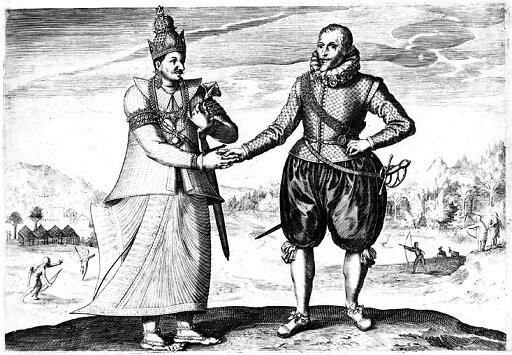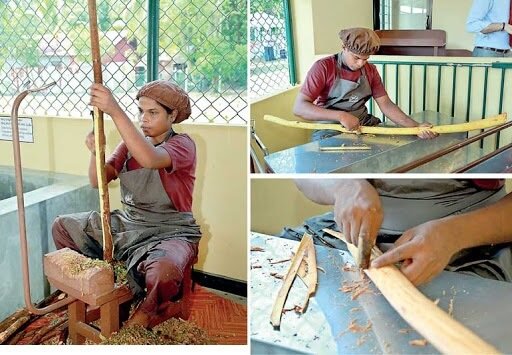Many of us may feel we are familiar with cinnamon sticks and powder. Furthermore, we think we know how to use this wonderfully warm and aromatic spice. But here in the UK, how much do we fully understand? Which type is best? What are the benefits? And apart from just taking what we are given in the supermarket, do we know where to buy the very best variety?
In the light of these questions, please join us now on a wonderful journey along a “colourful path of discovery” to find out why organically produced cinnamon really should be a must-have spice in your cabinet.
With this in mind, let’s begin by introducing you to the two main types of cinnamon. Firstly, there’s “Ceylon cinnamon” from Sri Lanka (and some southern parts of India). It is lighter in colour has some bright citrus tones. Secondly, we have “Cassia cinnamon” which is mainly from China and Indonesia. In addition, they also grow some sub-species in Vietnam and other parts of southern Asia. However, we are not going to cover those in this short article.
To clarify, both main varieties are from the same plant family. And they share one essential oil. However, the more sophisticated types that Zoetic imports from Sri Lanka contain an extra three oils. Undoubtedly, these give it a more complex flavour. And, unquestionably, this is why Ceylon cinnamon especially appeals to people with a “sweet tooth“.
Another key point which should be considered with Ceylon cinnamon is that the Sri Lankans still use the old fashioned peeling technique. Of course, apart from flavour and aroma, this labour-intensive processing explains why “Ceylon cinnamon” is more expensive than Cassia.
Generally, the harvest starts very early in the morning. At this time, the farm workers gather to sharpen their various tools. Firstly, they harvest the 2-year-old trees. After that, twice a year, it’s the turn of the young shoots.
A point often overlooked is that the varieties and grades of cinnamon depend on the part of the shoots that are harvested. To rephrase it, the lower parts of the shoot have thicker quills with a sweeter and woodier flavour. By comparison, the tips of the shoots, which are the higher grade, have thinner quills and a more delicate spicy flavour.
Specifically, the workers cut the 18 to 24 months old plants 20-30cms from the ground. Following that, they roughly gather the thin trunks, which are about 3 to 4 metres in length. Finally, they bind them securely with twine. The farmers then take them over to the main processing area.
The next step is to remove smaller branches from the trunks which they then cut into more manageable sizes. A team of skilled workers now manually scrapes off the outer bark. Nothing is wasted. They eventually use this bark as compost.
To clarify, they remove the outer layer as it contains coumarin, which has a quite bitter taste.
Afterwards, the next step is to soften the inner bark. The workers repeatedly run a brass bar up and down the spindly trunk until it becomes softer and easier to work. Eventually, they reach the point where they can skilfully remove the inner bark and set it aside. This is a highly-skilled job. It needs years of practice to do quickly with a minimum amount of waste.
Eventually, once the inner bark is removed, the strips are laid out to partially dry in the sun. They start curling as the moisture evaporates.
Now, the workers will gather together large strips of similar length, nesting one inside the next and so on. Any remaining gaps are filled with small pieces of the inner bark. Eventually, the end of each piece will look a bit like a top-quality cigar.
However, the drying stage is still not 100% complete. Afterwards, the pieces are left for a further 2 weeks. Generally, every day a group of workers will re-check the quills and manually roll them tighter. Once the quills are bone dry they can finally be cut again into the familiar 8cm – 10cm strips, ready for packaging.
“Ceylon Cinnamon” or “real” cinnamon is lighter in colour. The quills are much thinner and fall apart in your hand. Compared to Cassian Cinnamon, at a push, you may even be able to grind “real” cinnamon at home using a coffee grinder. We would not recommend it!
Cassia also goes by the names “Chinese cinnamon“, “Vietnamese cinnamon” and “Canela de China” amongst several others. It is much thicker, darker and far more prevalent. If you buy cinnamon in a UK supermarket, almost certainly it will be Cassia.

Sri-Lanka has long been regarded as the king of cinnamon.
Us humans have enjoyed it for thousands of years …
Then, some time in the middle ages, Arab and Middle Eastern traders brought it to Europe. Although it was very expensive, it instantly became very popular.
For years, the people from the East had a monopoly over the cinnamon trade. To secure this monopoly, the traders created fanciful tales about how they obtained this luxurious spice.
One such legend, reiterated by the Greek historian Herodotus, was that an enormous bird carried the cinnamon sticks up to their nests, perched high on top of an unscalable mountain peak. To collect the cinnamon, people would leave large pieces of ox meat below these nests for the birds to collect. When they brought the meat back to the nest, its weight caused the nest to collapse and fall to the ground. Thus, allowing the cinnamon sticks to be collected.
In the same fashion, another far-fetched tale was that the cinnamon was found in deep dark canyons guarded by thousands of poisonous snakes.
Europeans (like Christopher Columbus) set sail to find the source of this wonderful, luxurious spice. Columbus was one of the first to claim he had discovered it in the New World.
Furthermore, he wrote to Queen Isabella, but when he sent samples back home, it was discovered that the spice was not cinnamon after all.
Additionally, Gonzalo Pizarro, a Spanish explorer, also set sail the Americas in search of cinnamon. He was hoping to find “El Pais de la Canela” or “Cinnamon country” near the Amazon. But he did not succeed
On the contrary, in the early 1500s, Portuguese traders discovered cinnamon in Ceylon (or present-day Sri-Lanka). They conquered its island of Kotto and enslaved the local population. In this case, they gained almost total control of the cinnamon trade. Accordingly, this gave rise to the start of the famous spice wars.
Eventually, during 1638, the kingdom of Kandy requested the help of the “Dutch East Indian Company“. Henceforth, together, they conspired to defeat the Portuguese.
Significantly, after their victory, the Dutch held on to the kingdom. Therefore, once again the island was under the control of a European country. Without a doubt, the Dutch East Indian Company had a monopoly of the cinnamon trade for around a century and a half.
Eventually, in the late 1700s, the British took over the Island in the fourth Anglo-Dutch war.
Finally, by around 1800 this spice had become a less rare commodity. To clarify, this was principally due to the introduction of cassia as cinnamon.
We hope you have enjoyed this essay on Ceylon cinnamon vs Cassia Cinnamon and a brief look at the history of the spice. If you have any questions, please contact us.



As a way of showing remorse for killing his wife, Roman Emperor Nero burned a year’s supply of cinnamon at her funeral.
Finally, please note that we will soon be adding 2 types of cinnamon quills to our list of products, Alba and Hamburg grade 1. Cinnamon grown in Sri-Lanka comes in 4 varieties …
We offer 2 grades of quill, Alba and Hamburg 1.
Alba, the highest quality grade, is a tawny brown colour with a uniquely fresh warm scent. It is mild yet spicy and distinctively fresh with just a hint of citrus flavour.
Hamburg 1 or H1, is from the lower parts of the shoots, the colour is a bit lighter than Alba.
The scent is warm and woody, with a hint of floral. Slightly spicy, warm and a hint of sweet flavour.
Cinnamon has many beneficial properties. It’s anti-inflammatory, boosts cognitive function and brain health. Contains substanial amount of Manganese, helps prevent and fights candid, aids weight loss. It has anti-diabetic effects and reduces cramps and symptoms of menstruation.
Cinnamon helps to increase the flow of mother’s milk. It will also help in delaying periods after childbirth. A pinch of cinnamon should be added to half a teaspoon of honey or to a glass of warm milk and consumed.
If you look after your spice it will never go bad. Cinnamon quills will keep their potency for 2 years and after that they will gradually loose their aroma and flavour. Ground cinnamon on the other hand will loose its potency much faster, It’s better to use it within 1 year. If you keep your spice in a cabinet away from humidity then you’ll definitely enjoy its flavour and aroma for longer.
Ceylon cinnamon is harvested once or twice per year. When a tree is 2 years old it is first harvested and then once or twice per year the young shoots will be harvested. The tree will grow back in time for the next harvest. It is more of a pruning rather than chopping.
It’s filled with antioxidants and health benefits include reduced inflammation and blood sugar levels, improved heart health, and perhaps even weight loss.
If you go to a supermarket or spice market, you will probably be offered cassia, rather than “true” or “real” cinnamon. Packaging laws, particularly in the US, don’t require manufacturers to specify which is which. Cassia might be ok for basic home use, if you are adding it to a curry along with numerous other spices. However, if it is the only spice in a dish the variety from Sri Lanka is the clear winner. Try sprinkling it on warm porridge or add it to a banana or mango smoothie. Zoetic only sell top-quality, certified Ceylon cinnamon.